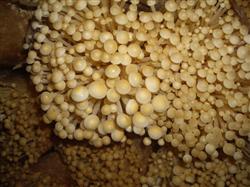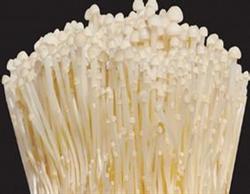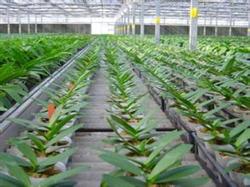Five methods of Water Management of Flammulina velutipes at fruiting stage

Flammulina velutipes is not only a delicious food, but also a good health food. Flammulina velutipes has an increasingly broad market at home and abroad. However, the requirements of cultivation and management of Flammulina velutipes are higher, especially for the development of fruiting body. Now China Agricultural Technology Network introduces the method of water management for reference. Moisturizing and promoting buds. When the mycelium is sent to the bottom of the bag, immediately open the bag to scratch the bacteria, rake off the old bacterial skin, cover with wet newspaper or plastic film to moisturize and bud. If the newspaper is covered, it should be sprayed a few times (3 times a day, 4 times a day) to keep the newspaper moist; if covered with plastic film, it can spray water to the ground and space, keeping the air humidity about 90%. In this period, the window was opened and ventilated once a day, the room temperature was controlled at 10 ℃ and 14 min, and a large number of mushroom buds occurred in 7 days. Cooling and humidity. When the mushroom bud grows to 1mi 2cm, it enters the growth inhibition period. At this time to reduce or stop spraying water, reduce humidity. Open the doors and windows at night for 5 consecutive days, let the cold air cool and dissipate humidity, lower the room temperature to less than 8 ℃ (4 Mel 5 ℃ is the best), and the humidity is about 75%, so that the fruiting body is restrained and the growth is neat and sturdy. Promote growth. The fruiting body grew to 4cm. After entering the extension period, the fruit body was sprayed 4 times per day for 5 times. The amount of spraying water increases with the growth of mushrooms, and the air humidity is about 90% (that is, fine water droplets are attached to the bag wall at the base of the fruiting body) to promote the rapid growth of the fruiting body. At the same time, proper ventilation and alternation of dry and wet were adopted to inhibit the increase of mushroom cover and promote the elongation of mushroom stalk. The amount of spraying water at this stage should be determined according to the weather, spraying more in sunny days and less in rainy days, so as to prevent root rot, brown spot and mushroom body from reducing quality due to excessive use of water. Do not spray water on the mushroom cover, find that the newspaper is damaged and replace it in time, and pour out the stagnant water on the newspaper immediately to prevent the mushroom body from coming into contact with water droplets to produce black spots and affect the appearance of the goods. Spray water to moisturize. After the mushroom was harvested, the water content of the mushroom decreased by 20%, 30%, and 30%, respectively. Therefore, after the first and second tide mushrooms are harvested, it is necessary to spray water into the bacteria bag immediately after scratching. The method is to spray water directly into the bag 3 times a day for 3 consecutive days, and each time the surface of the bacteria column should be moist, so as not to make the bag accumulate water. In order to increase the yield, a small amount of urea, sugar and potassium dihydrogen phosphate can be added to the water to supplement nutrients. The bacteria column is immersed in water. After the three tide mushrooms were harvested, the water content of the bacteria column has been reduced to less than 50%. At this time, the plastic bag can be removed, and the bacteria column can be soaked in the pool water. When the bacteria column absorbs water and returns to its original weight when opening the bag, it can be slightly dried and loaded into the bag. The bag can also be soaked with water directly, and the excess water in the bag can be cleaned after the bacteria column absorbs enough water. After replenishing the water, the bacterial bag will be rearranged on the bedstead, and the wet newspaper will be managed as usual, so that two tide mushrooms can be picked. The water management of Flammulina velutipes during mushroom emergence period is related to the yield and quality of Flammulina velutipes. Therefore, it is necessary to master the water management of Flammulina velutipes. Through the above five methods, Flammulina velutipes can be harvested more than two tide mushrooms and the yield can be increased.
- Prev

High-yield cultivation techniques of Flammulina velutipes in Northeast China
Flammulina velutipes is a kind of high-grade food in edible fungi with high nutrition and health care value. at present, it has become a necessary raw material in hot pot in our region and is welcomed by the majority of consumers. In order to further improve the yield and quality of Flammulina velutipes, according to years of personal practice, the technical points of high-yield cultivation of Flammulina velutipes were summarized.
- Next

Remediation of drug damage caused by paclobutrazol in orchid
Orchid has been one of the most famous ornamental flowers in China since ancient times. its soft and beautiful leaves, elegant and clean flowers and exquisite fragrance make it a treasure in the flowers. There are about 500 genera and more than 10,000 species of orchids in China. Orchids are commonly seen as terrestrial orchids in the genus Cymbidium. According to its florescence can be roughly.
Related
- Fuxing push coffee new agricultural production and marketing class: lack of small-scale processing plants
- Jujube rice field leisure farm deep ploughing Yilan for five years to create a space for organic food and play
- Nongyu Farm-A trial of organic papaya for brave women with advanced technology
- Four points for attention in the prevention and control of diseases and insect pests of edible fungi
- How to add nutrient solution to Edible Fungi
- Is there any good way to control edible fungus mites?
- Open Inoculation Technology of Edible Fungi
- Is there any clever way to use fertilizer for edible fungus in winter?
- What agents are used to kill the pathogens of edible fungi in the mushroom shed?
- Rapid drying of Edible Fungi

